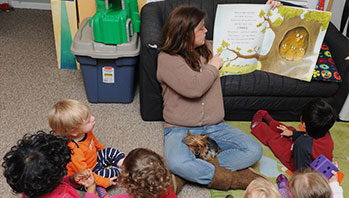- move
- nonfiction
- ramp
MA Standards:
Reading for Informational Text/RI.P.MA.1: With prompting and support, ask and answer questions about an informational text read aloud.
Reading for Informational Text/RI.P.MA.: With prompting and support, “read” illustrations in an informational picture book by describing facts learned from the pictures (e.g., how a seed grows into a plant).
Reading for Informational Text/RI.P.MA.7: With prompting and support, describe important details from an illustration or photograph.
Reading for Informational Text/RI.P.MA.10: Listen actively as an individual and as a member of a group to a variety of age-appropriate informational texts read aloud.
Head Start Outcomes:
Literacy Knowledge/Book Appreciation and Knowledge: Asks and answers questions and makes comments about print materials.
PreK Learning Guidelines:
English Language Arts/Reading and Literature 6: Listen to a wide variety of age appropriate literature read aloud.
English Language Arts/Reading and Literature 10: Engage actively in read-aloud activities by asking questions, offering ideas, predicting or retelling important parts of a story or informational book.
English Language Arts/Reading and Literature 13: Relate themes and information in books to personal experiences.
Read Together: Roll, Slope, Slide: A Book About Ramps #2

© Commonwealth of Massachusetts, Department of Early Education and Care (Jennifer Waddell photographer). All rights reserved.
STEM Key Concepts: A ramp, or inclined plane, is a surface with one end higher than the other; Identify tools and simple machines used for a specific purpose, e.g., ramp, wheel, pulley, lever
ELA Focus Skills: Concepts of Print, Comprehension, Parts of a Book, Speaking and Listening, Vocabulary
Before You Read
Show children the cover of Roll, Slope, Slide: A Book About Ramps by Michael Dahl. Have them locate the title and the names of the author and illustrator. Read the words aloud, tracking the words as you do.
Have children point to the ramps on the cover and give children a listening focus by asking them to think about how ramps make it easier to do some things. Ask,
- How do you think the ramp makes it easier for the boy riding his skateboard?
As You Read
Carry out a picture walk of the book as you ask questions such as,
- Page 4: How do you think a ramp makes it easier to move heavy furniture into a building? (don’t have to climb stairs; can push instead of carry)
- Page 9: How does the ramp make it easier to move the luggage? Help children conclude that it would take the man longer to carry each piece of luggage up the steps and onto the plane.
- Pages 12–13: Point out that the girl can go in and out of the building on her own because of the ramp.
- Page 21: Help children make a text-to-text connection by having them recall the story Roller Coaster. Point out that the operator is putting on a brake. Ask children if they recall what job the brake did on the roller coaster cars.
After You Read
Ask children to share any ramps they have seen inside or outside their school. Ask, How did the ramp help make something easier to do?
Ask children if they have seen any of the ramps shown in the book. Ask, Do you know what the ramp is used for? How do you know?
Adaptation: Each time you read the story, focus on teaching young children one or two new words.
Take It Further: For groups with children showing an interest in learning more, have them carry out the activity on page 22.
English Language Learners: Invite children to make connections between the pictures and their own lives. For example, point to the illustration on pages 6–7 and say, These children like to skateboard outdoors. What do you like to do outdoors?
